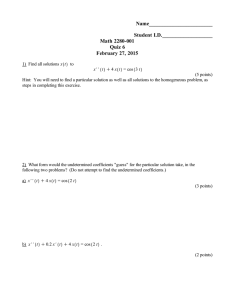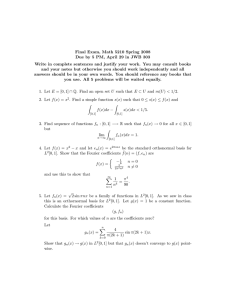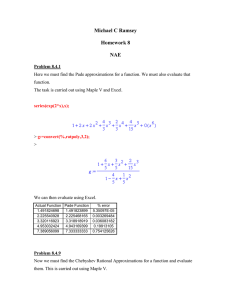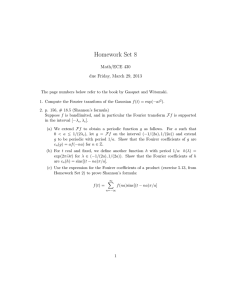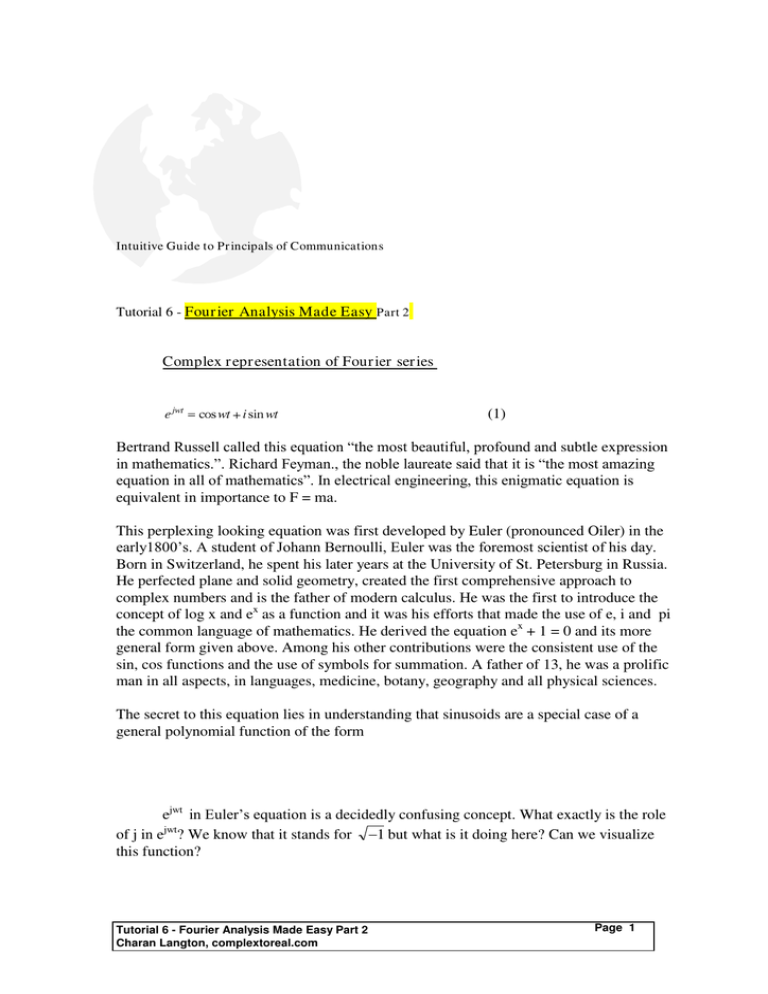
Intuitive Guide to Pr incipals of Communications
Tutorial 6 - Four ier Analysis Made Easy Part 2
Complex r epr esentation of Four ier ser ies
e jwt
cos wt i sin wt
(1)
Dgtvtcpf"Twuugnn"ecnngf"vjku"gswcvkqp"Ðvjg"oquv"dgcwvkhwn."rtqhqwpf"cpd subtle expression
kp"ocvjgocvkeu0Ñ0"Tkejctf"Hg{ocp0."vjg"pqdng"ncwtgcvg"uckf"vjcv"kv"ku"Ðvjg"oquv"coc|kpi"
gswcvkqp"kp"cnn"qh"ocvjgocvkeuÑ0"Kp"gngevtkecn"gpikpggtkpi."vjku"gpkiocvke"gswcvkqp"ku"
equivalent in importance to F = ma.
This perplexing looking equation was first developed by Euler (pronounced Oiler) in the
gctn{3:22Óu0"C"uvwfgpv"qh"Lqjcpp"Dgtpqwnnk."Gwngt"ycu"vjg"hqtgoquv"uekgpvkuv"qh"jku"fc{0"
Born in Switzerland, he spent his later years at the University of St. Petersburg in Russia.
He perfected plane and solid geometry, created the first comprehensive approach to
complex numbers and is the father of modern calculus. He was the first to introduce the
concept of log x and ex as a function and it was his efforts that made the use of e, i and pi
the common language of mathematics. He derived the equation ex + 1 = 0 and its more
general form given above. Among his other contributions were the consistent use of the
sin, cos functions and the use of symbols for summation. A father of 13, he was a prolific
man in all aspects, in languages, medicine, botany, geography and all physical sciences.
The secret to this equation lies in understanding that sinusoids are a special case of a
general polynomial function of the form
ejwt kp"GwngtÓu"gswcvkqn is a decidedly confusing concept. What exactly is the role
of j in ejwt? We know that it stands for /1 but what is it doing here? Can we visualize
this function?
Tutorial 6 - Fourier Analysis Made Easy Part 2
Charan Langton, complextoreal.com
Page 1
Before we continue the discussion of Fourier Series and its complex
rertgugpvcvkqp."ngvÓu"hktuv"vt{"vq"ocmg"ugpug"qh"gjwt as it relates to signal processing.
Take any real number, say 3, and plot it on a X-Y plot as in Fig 1a. Multiply this
number by j, so it becomes 3j. Where do we plot it now? Herein lies our answer to what
multiplication with j does.
Y
3j
Each time the number is
multiplied by oi,
it shifts by 90 .
Y
3i
Phase shift due to
multiplication with j
3
-3
X
X
3
Figur e 1a - Relationship of r eal
and imaginar y number s
-3j
Figur e 1b Î Multiplication with j
r epr esents a phase shift
The number stays exactly the same, 3j is the same as 3, except that multiplication
with j shifts the phase of this number by +90o. So instead of an X-axis number, it
becomes a Y-axis number. Each subsequent multiplication rotates it further by 90o in the
X-Y plane as shown in Figure 1b. 3 become 3j, then -3 and then -3j and back to 3 doing a
complete 360 degree turn. Division by j means the opposite. It shifts the phase by -90o.
(Question: What does division by -j mean?)
Alternately, imagine a number that is multiplied by -1. In Cartesian sense, we say
that the point has now rotated 180o to the negative x-axis. Another multiplication by a -1
rotates back to the positive x axis. If that is the case, then a square root of -1 can be
conceptualized as a rotation of 90 o. A rotation of - /1 can be seen as a 270o rotation.
This is also essentially the concept of complex numbers. A compound number
called the complex number consists of numbers in more than one dimension. The
operator I is used to indicate this dimensional difference. Complex numbers often thought
qh"cu"Ðeqornkecvgf"pwodgtuÑ"hqnnqy"cnn"qh"vjg"eqooqp"twngu"qh"ocvjgocvkeu0"Yjgtgcu"kp"
calculus of real numbers, we deal with numbers along a line in one dimension, in
complex math, we allow numbers to move in many dimensions and have an another
property called phase associated with them. Perhaps a better name for complex numbers
would have been 2D numbers.
Tutorial 6 - Fourier Analysis Made Easy Part 2
Charan Langton, complextoreal.com
Page 2
To further complicate matters, the axes, which were called X and Y in our
Cartesian mathematics are now called respectively Real and Imaginary. Why so? Is the
quantity 3j any less real than 3?
This semantic confusion is the unfortunate result of the naming convention of
complex numbers and helps to make them confusing, complicated and of course complex
Y
3
ejwt
3+j3
sin wt
X
X
3
cos wt
Figur e 2 Î a. Plotting complex number s
b. plotting a complex function
Pqy"ngvÓu"rnqv"c"eqorngz"pwodgt."5"-"l50""Kp"Ectvgukcp"ocvj"we would write this
number as (3,3) indicating 3 units on the X-axis and 3 units in the Y-axis. Similarly, the
real quantity is plotted on the X-axis (real part) and the j coefficient (imaginary part) is
plotted on the Y-axis. These are the X-Y projections of this number. The projection
magnitudes are real and not encumbered by the vexing j.
A complex number can have for its coefficients, instead of numbers, equations
(cos x, sin x). We plot these in exactly the same way as shown in Figure 2b except that X
and Y projections instead of being numbers, are functions, namely sine and cosine in this
case.
Pqy"ngvÓu"vcmg"c"nqqm"cv"vjg"gjwt again. It is called a Cisoid {(cos x + j sin x)usoid} from
eqpvtcevkqp"qh"vjg"rctvu"qh"vjg"GwngtÓu"gswcvkqp0"
Now forget about the ejwt part and concentrate only on the RHS containing sines
and cosines.
e jwt ? cosyt - j sin yt
We plot this function by setting the X-axis = cos wt and the Y-axis = sin wt. This
plot is shown in Figure 3.
Tutorial 6 - Fourier Analysis Made Easy Part 2
Charan Langton, complextoreal.com
Page 3
Figur e 3 Î ejwt plotted in thr ee dimensions is a helix
Imaginary Axis
sin wt
cos wt
Time
Real Axis
In Figure 3 cos wt is plotted on the Real axis and sin wt is plotted on the
Imaginary axis. The function looks like a helix moving forward in time to the right. The
X-Z and the Y-Z projections, if plotted, would be the sine and cosine functions.
Had we plotted the function e-jwt, we would have seen that it moves to the left
instead of to the right. This direction of rotation has important implications for the
definition of frequency.
Vjg"swcpvkv{"Ðgg-to-the-jay-omega-vggÑ"ks a mouthful and is commonly called a
Phasor, particularly in electrical engineering. Phasors are plotted with time dimension
suppressed, so they look like a vector frozen in time with its plane rotating with the
angular frequency of the cisoid.
Now letÓu"gzrtguu"ukpgu"cpf"equkpgu"kp"vgtou"qh"qwt"pgy"swcpvkv{"gjwt. So we have
Tutorial 6 - Fourier Analysis Made Easy Part 2
Charan Langton, complextoreal.com
Page 4
e jwt ? cos wt - j sin wt
and
-?
?
-
(2)
e / jwt ? cos wt / j sin wt
Manipulating these two equations, we get
e jwt / e / jwt
sin wt ?
2j
cos wt ?
(3)
e jwt - e / jwt
2
Pqy"ngvÓu"lwuv"uwduvkvwvg"S+, for ejwt and Q- for e-jwt , we get
cos wt ?
Q- - Q/
2
(4)
Q / Q/
sin wt ? 2j
The use of Q is just to make it easier to see what is happening. We have redefined
sine as a difference between two phasors Q+ and Q- and cosine as the sum of the same of
the same two phasors. The presence of j in the definition of sine means that it is -90o to
the other term and nothing more. So mentally erase the j in the denominator, if it bothers
you.
The phasor Q+ is arbitrarily defined to rotate in the counterclockwise direction and
the Q- phasor in the clockwise direction. The vector sum of these two phasors is changing
with time and represents the cosine and sine functions. In Figure 4 we show two phasors
at a particular time. They always rotate in opposite directions and meet each other at 0
and 180 degrees. Their instantaneous vector sum equals the quantity (2 cos(wt)) and their
vector difference equal (2 sin(wt).)
Tutorial 6 - Fourier Analysis Made Easy Part 2
Charan Langton, complextoreal.com
Page 5
Y
2sinwt = ejwt - e-jwt
e-jwt
ejwt
Q+
Q-
Phasor Q+ rotates
counter clockwise
with time
X
Phasor Q- r otates
clockwise
with time
2coswt = ejwt + e-jwt
Figur e 4 Î ejwt and e-jwt phasor s
In Figure 5 we plot the progression of these two phasors to see how their sum and
differences would equal the cosine and sine function. Each picture depicts the phasors at
a particular time. Time is increasing as one moves from left to right then to retrace as in
reading a page.
Imaginary
Imaginary
2 sinwt = 2/sqrt(2)
ejwt
1
2 sinwt = 0
1
ejwt
1
e-jwt
Real
2
2 cos wt = 2
Real
2 coswt = 2/sqrt(2)
1
e-jwt
Figur e 5a - Phasor r epr esentation of sine and cosine, 1. Wt = 0, 2. Wt = pi/4
At t = 0, both phasors are horizontal. Their vector sum is twice the length of each.
So cos wt = 1 and since the difference is zero, sin wt = 0
At t = pi/4, the Q- phasor has rotated up to pi/4 and the Q- phasor has rotated to pi/4. Now their vector sums, give us cos wt = 1/sqrt 2 and their difference gives also
1/sqrt2.
Tutorial 6 - Fourier Analysis Made Easy Part 2
Charan Langton, complextoreal.com
Page 6
4. wt = 3r16
3. wt = r14
Imaginary
Imaginary
At wt = -3pi/4
ejwt
ejwt
2 sinwt = 2
Real
Real
2 coswt = -2/sqrt(2)
2 cos wt = 0
2 sinwt = 2/sqrt(2)
e-jwt
e-jwt
Figur e 5b - Phasor r epr esentation of sine and cosine, 1. Wt = pi/2, 2. Wt = 3pi/4
At t = pi/2, Q+ phasor has rotated upright and the Q- has rotated down to the
opposite side. Now the vector sum gives us the cos wt = 0 and sin wt = 1.
At t = 3pi/4, we get the same situation as at t = 0, but the cosine term is negative
as it should be.
Imaginary
5. wt = r
ejwt
Real
-2 cos wt = -2
"
e-jwt
2 sin wt = 0
Figur e 5c- Two phasor s at wt = pi/2
At wt = pi/2, the phasors meet again. The sine term which is the difference is once
again zero and the cosine term is the sum of the two magnitudes and as such cos wt = 1
and sin wt =0.
By following each phasor we see that at every t, we get the conventional and
correct values of sine and cosines.
Tutorial 6 - Fourier Analysis Made Easy Part 2
Charan Langton, complextoreal.com
Page 7
Now we make the following important points that will help us in dealing with concepts of
negative frequency and signals in quadr atur e.
1. Cosine wave is sum of two phasors rotating in opposite directions divided by 2.
2. Sine wave is difference of the same two phasors divided by 2.
3. Since any real periodic signal can be represented as a sum of sines and cosines, then it
also be represented as a sum of positive and negative phasors (also called
exponential).
4. Just as we could create a spectrum out of the coefficients of the sinusoids, we can do
the same thing out of the coefficients of the phasors.
If we think about sine and cosines strictly in terms of phasors and forget about the
old trigonometric definition of sine in terms of frequency and amplitude, we can talk
about (but using old terminology) the concept of negative frequency.
We can say that both sine and cosine waves are made up of two quantities called
phasors, a phasor of positive frequency, ejwt and a phasor of negative frequency, e-jwt. So
both sine and cosine contain negative frequency content. The idea is similar to talking
about negative colors or negative people. These are perceived as physical properties and it
is hard for us visualize them as negative. But when seen from a mathematical perspective,
there is such a thing as a negative color; white can bee seen as negative of black and
according to my esteemed colleague Dr. Dave Watson, there is definitely such a thing as
Ðpgicvkxg"rgtuqp0Ñ"dwv"qh"eqwtse none in Advanced Systems!
This terminology is confusing because in complex domain we are not talking
about frequency at all but the exponent of the exponential, ejwt. The Q+ phasor represents
the positive frequency content and the Q- phasor the negative frequency because of the
sign of the exponent. Each phasor then represents only the positive or the negative
frequency.
Here is a hardware oriented view of negative frequency. A two-pole permanent
magnet AC generator connected to same shaft with their field windings in space
quadrature will produce a positive frequency output by driving the shaft in one direction
of rotation. And a negative frequency output when driven in the opposite direction. So it
is direction of the motion that determines the sign of the frequency.
The difficulty is that frequency is really a two dimensional concept but is often
seen only as one. Two dimensions are needed to describe a frequency, its cycles per
second and its direction of rotation. Historically we have always talked of frequency as a
physical quality of a wave. Spectrum analyzers and other electrical measuring devices are
one dimensional as well which limits our understanding of the general concept of
frequency.
The general concept of frequency can be written as follows
Tutorial 6 - Fourier Analysis Made Easy Part 2
Charan Langton, complextoreal.com
Page 8
f ?
dh
dt
We can define frequency as the rate of change of phase over time. So a + 2r rotation over
half second means the frequency is 2. And here we see that if phase rotates around
counter-clockwise, then we have the definition of positive frequency and when it goes the
other way then it is negative. A - 2r rotation over half second means the frequency is -2.
Velocity or speed which we also tend to think of as a scalar has a similar confusing
aspect. We can talk about 60 miles per hour and this makes perfect sense. But what does
Î60 miles per hour mean? Mathematically it is a perfectly OK construct. It just means
same speed but going backwards. The concept of negative frequency is just as simple as
that.
What use is ejwt ? Why bother with it at all?
Recall that we can use a sinusoid as a filter. When we multiply a signal by a
sinusoid of a particular frequency, the product when integrated reveals the frequency of
the sinusoid hidden in the signal. To compute trigonometric coefficients, this is
essentially what we do, we multiply a random signal by sinusoids of different frequencies
to yield all its frequency components. Multiplying by ejwt does exactly same thing. Except
that now instead of doing sines and cosines one at a time we can do them both together.
The function allows us to deal with two dimensional signals together.
We can also interpret the multiplication as a form of frequency shifting. When we
multiply a signal by ejw0t, then we are essentially isolating and shifting that signal to the
w0 frequency to the right. When we multiply it by a e-jw0t, then we are shifting it leftwards
to - w0.
Figure below shows the effect of this multiplication. Figure 8a shows the
Amplitude spectrum centered about frequency = 2. Multiplying this signal by e j ( 2rf ) t
where f = 2 causes the spectrum of the new signal to shift to 4 for a total shift of f = 2.
When we multiply this signal by e j ( 2rf ) t where f = -2 causes the spectrum of the new
signal to shift to 0 for a total shift of f = -2 as in Figure 8c.
This important property of Cisoid allows us to shift signals from baseband to
carriers and vice versa. It is a fundamental equation whenever we talk about modulation.
Tutorial 6 - Fourier Analysis Made Easy Part 2
Charan Langton, complextoreal.com
Page 9
0
1
2
3
Frequency
Figur e 6a - Amplitude Spectr um of an ar bitr ar y signal f(t)
0
1
2
4
3
Frequency
Figur e 6b - Amplitude of signal f(t) multiplied by e
-1
0
1
2
j 4 rt
3
4
Frequency
Figur e 6c - Amplitude Spectr um of signal f(t) multiplied by e
Tutorial 6 - Fourier Analysis Made Easy Part 2
Charan Langton, complextoreal.com
5
5
/ j 4rt
Page 10
Back to the Four ier Ser iesÏ
Recall that Fourier Series is a sum of sinusoids.
N
f (t ) ? a 0 -
Â
N
a n sin( wn t ) -
n ?1
Âb
n
cos( wn t )
(5)
n ?1
The coefficients a0, an and bn (which we can call the trignometric coefficients) are defined
as
a0 ?
an ?
Ð f (t )dt
2
T
Ð f (t ) sin nwt dt
2
T
bn ?
T
1
T
0
T
0
T
Ð f (t ) cos nwt dt
0
Now substitute Eq 4a and 4b as the definition of sine and cosine into Eq 5, and we get
N
f (t ) ? a 0 -
an
 2 (e
jnwt
/ e / jnwt ) -
n ?1
bn jnwt
(e
/ e / jnwt )
2i
(6)
Pqy"ngvÓu"ocmg"vjg"ucog"uwduvkvwvkqp"kp"vjg"gswcvkqpu"hqt"vjg"rtgxkqwun{"fgtkxgf"Hqwtkgt"
coefficients.
an ?
bn ?
2
T
2
T
T
1
Ð f (t ) 2i (e
jnwt
- e jnwt )dt
(7a)
0
T
Ð f ( t ) 2 *e
1
jnwt
+
/ e / jnwt dt
(7b)
0
Expanding and rewriting Eq 6, we get
¢
1
1
f ( t ) ? a 0 - Â ( a n / ibn )e jnwt - ( a n - ibn )e / jnwt
2
n ?1 2
(8)
the coefficients in Eq 7 can be written as follows by just rearranging and simplifying.
Tutorial 6 - Fourier Analysis Made Easy Part 2
Charan Langton, complextoreal.com
Page 11
an ?
1
T
ibn ?
1
T
T
Ð
f ( t )e jnwt dt -
0
T
Ð
f ( t )e jnwt dt /
0
1
T
1
T
T
Ð f (t )e
/ jnwt
dt
(9a)
0
T
Ð f (t )e
/ jnwt
dt
(9b)
0
Kp"gzrqpgpvkcn"htqo."vjgug"ctg"mkpf"qh"jctf"vq"ytkvg."uq"ngvÓu"tgfghkpg"pgy"
coefficients An and Bn
1
( a n / jbn )
2
1
Bn ? ( a n - jbn )
2
An ?
(10a)
(10b)
Substituting these new definition into the Eq 6, we get a much simpler
representation
¢
f (t ) ? a 0 -
ÂAe
jnwt
n
- Bn e / jnwt dt
(11)
n ?1
An ?
1
T
T
Ð f (t )e
jnwt
dt
0
(12)
Bn ?
1
T
T
Ð f (t )e
/ jnwt
dt
0
It is clear from the above equation that An can be seen as the coefficients of the
positive frequency and Bn the coefficient of the negative frequency.
Do you remember that the term a0 stands for the DC term in Eq 11. We generally
do not like DC terms so we will try to get rid of it by expanding the range of the second
term from 1 to infinity to include 0 so it goes from 0 to infinity instead and as such
includes the DC term.
Rewrite Eq 11 as
¢
f (t ) ? a 0 -
ÂAe
jnwt
n
- Bn e / jnwt dt
(13)
Bn e / jnwt dt
(14)
n ?1
¢
f (t ) ?
ÂAe
n
n?0
¢
jnwt
-
Â
n ?1
Note that the index changed from 1
Tutorial 6 - FouriertoAnalysis
Made
Easy
Part
2
0 to include
the first
(DC)
term.
Charan Langton, complextoreal.com
Page 12
The above equation can be simplified still further by extending the range of the
coefficients from -1 to -infinity. We can do this by changing the sign of the index.
Combine the two terms of Eq 14 to write a much more compact and elegant equation for
the Fourier Series.
And here is our much shorter equation for Fourier Series.
¢
f (t ) ?
ÂC e
jnwt
(15)
n
n?
The above is called the exponential or the complex form of the Fourier Series. It is
rigorously related to the sinusoidal form but its coefficients Cn are generally complex.
Note that our index (or the frequency) was always positive before and the
spectrum was one sided. Now the index goes from - ¢ to + ¢ . We have by a
mathematical trick taken the perfectly good one-sided spectrum computed by the
trigonometric coefficients and now folded it over to make a two sided symmetrical
spectrum. Its coefficients are exactly half of the one-sided coefficients.
The coefficient Cn is given by
Cn ?
1
2T
T
Ð f (t )e
/ jnwt
dt
/T
Cn is related to the trigonometric coefficients by
Cn ? An - jBn
The magnitude and phase of Cn is defined by
Cn ?
An - Bn
2
2
à Bn Ô
Õ
Å An Ö
h n ? tan /1 Ä
An and Bn can be seen as the coefficients on each side of the origin.
Example 1 - Four ier coefficients of a cosine wave
Tutorial 6 - Fourier Analysis Made Easy Part 2
Charan Langton, complextoreal.com
Page 13
f (t ) ? Acos wt
A
A
? Q- - Q/
2
2
We get the trigonometric coefficients from looking at the first equation. It is simply A and
it is at f = 1.
We get the complex coefficients by looking at the coefficients of the two phasors
in the second equation. They are A/2 located at +f and -f. The two spectrums are shown
below.
v(t)
[V]
A/2
A
[V]
A/2
t
f
Real
Real
2. v(t) = A cos wt
Figur e 7 - Single and double-sided spectr um of a sine wave
Example 2 - Four ier coefficients of a sine wave
f (t ) ? Asin wt
A
A
?
Q- /
Q/
2j
2j
We get the trigonometric coefficients from looking at the first equation. It is
simply A and it is at f = 1 just as it was for the cosine wave above.
We get the complex coefficients by looking at the coefficients of the two phasors
in the second equation. They are A/2 and -A/2 located at +f and -f. The two spectrums are
shown below. Note the sign change in the coefficients of the negative frequency phasor.
Presence of j tells us that we have to plot the coefficients -90 phase shifted. Figure below
shows this plot.
Tutorial 6 - Fourier Analysis Made Easy Part 2
Charan Langton, complextoreal.com
Page 14
v(t)
[V]
[V]
A
t
A/2
A/2
f
Real
Real
2. v(t) = A sin wt
Figur e 8 - Single and double-sided spectr um of a sine wave
Example 3 - Four ier coefficients of f(t) = A(cos wt + sin wt)
f (t ) ? A(cos w - sin wt )
A
A
A
A
? Q- - Q/ Q- /
Q/
2
2
2j
2j
We get the trigonometric coefficients from looking at the first equation. It is
simply A times the square root of 2 and it is at f = 1.
We get the complex coefficients by looking at the coefficients of the two phasors
in the second equation. Q+ phasor which has two coefficients each 90 degrees from each
other. The same is true for Q- phasor.
Note the coefficients of sine wave are 90 degrees to the cosine coefficients just as
they were in Example 2 Figure below shows this plot.
v(t)
[V]
sqrt(2)*A
[V]
sqrt(2)*A
sqrt(2)*A/2
t
sqrt(2)*A/2
f
Real
Real
2. v(t) = A cos wt + A sin wt
Figur e 9 - Single and double-sided spectr um of f(t) = A (cos wt + sin wt)
Tutorial 6 - Fourier Analysis Made Easy Part 2
Charan Langton, complextoreal.com
Page 15
Example 4 - Four ier coefficients of a complex signal f(t) = A(cos wt + jsin wt)
f (t ) ? A(cos w - j sin wt )
A
A
A
A
? Q- - Q/ - Q- / Q/
2
2
2
2
We can split the first equation into sine and cosine and the trigonometric
coefficients are as in Ex 1 and 2. We sum the two contributions to get A times the square
root of 2 at f = 1.
Now here we see something interesting. Note the coefficients of Q- by sine is
rotated up to be coincident with the coefficient of cosine. The two subtract. On the
positive side, once again, they are coincident but they add. The complex phasor Q- makes
no contribution at all. It cancels out. So we see a single valued delta function at positive
frequency only. This is a surprising and perhaps a counter-intuitive result.
v(t)
[V]
sqrt (2)*A
sqrt(2)*A
[V]
sqrt (2)*A/2
t
f
Real
Real
2. v(t) = A cos wt + j A sin wt
Figur e 10 - Single and double-sided spectr um of a complex signal f(t) = cos wt + j sin wt
Example 5 - a constant signal
Tutorial 6 - Fourier Analysis Made Easy Part 2
Charan Langton, complextoreal.com
Page 16
[V]
v(t)
A2/2
t
Real
f
Figur e 11 - f(t) = a constant
We can write the F(t) as an exponential of zero frequency.
f ( t ) ? Acos( w ? 0)t
A
A
? Q- - Q/
2
2
From the first representation, we get the trigonometric coefficient = A at w =0.
From the second representation we get the two complex coefficients, A/2 and A/2
but both are at w = 0 so their sum is A which is exactly the same as the trigonometric
representation.
The function f(t) is a non-changing function of time and we classify it as a DC
signal. The DC component if any always shows up at the origin for this reason.
Example 6 - a r eal signal
f (t ) ?.3 cos 2rtt /.5 sin 2rt -.9 cos 4rt -.6 sin 4rt /.2 cos 6rt -.3sin 6rt
Figur e 12 - A per iodic signal
Tutorial 6 - Fourier Analysis Made Easy Part 2
Charan Langton, complextoreal.com
Page 17
By inspection alone, we can draw its one-sided amplitude spectrum. The signal
has three harmonics, at f = 1, f = 2 and f = 3. We can write down the trigonometric a and
b coefficients for each harmonic just by looking at the signal f(t) equation.
Harmonic 1
a1 = .3
b1 = -.5
Harmonic 2
a2=.9
b2 = .6
Harmonic 3
a3 = -.2
b3 = .3
Creating the spectrum is a simple matter of summing ( ? ( a 1 ) 2 - ( b1 ) 2 ) the a and
b coefficients for each harmonic and drawing them as shown below.
1.08
.58
.36
w=1
w=2
w=3
Frequency
Bandwidth
Figur e 13 - One sided Spectr um of f(t)
Pqy"ngvÓu"ftcy"vjg"urgevtwo"qh"vjg"ucog"ukipcn"wukpi"vjg"eqorngz"hqto0"Htqo"Gs"
16, we have the complex coefficients An and Bn. From these, we can compute Cn.
1
An ? ( a n / ibn )
2
An ?
1
2
2
a n - bn
2
1
Bn ? ( a n - ibn )
2
Bn ?
1
2
2
a n - bn
2
Cn ?
Cn ?
1
2
2
a n - bn
2
An - Bn
2
2
We can see that the magnitude of the coefficient C is exactly half of the singlesided spectrum magnitude. We compute Cn for positive n and since this is a real signal,
Cn for negative n are equal to ones for the positive n.
Tutorial 6 - Fourier Analysis Made Easy Part 2
Charan Langton, complextoreal.com
Page 18
.54
.29
-1
-2
.18
1
-3
2
3
Frequency
Bandwidth
Figur e 14 - Two-sided spectr um fr om complex r epr esentation of Four ier ser ies
Magnitude and Power spectr um of a signal der ived fr om the Four ier coefficients
The spectrum we draw from the Fourier Series coefficients is called the
Magnitude spectrum or loosely just called the spectrum. The spectrum quantities are
always 0 or greater than zero and never negative. So there is something that is never
negative, and that is Power.
Vjg"cornkvwfg"urgevtwo"ecp"dg"eqpxgtvgf"vq"vjg"rqygt"urgevtwo"d{"vjg"RctugxcnÓu"
relationship
1
Pg ?
T
T
Ð v( t )
0
2
dt ?
¢
ÂC
n?
2
n
¢
?
ÂC C
n
n?
*
n
The relationship says that the power in any tone is just the square of its amplitude. (for R
= 1 ohm) The division by T gives us the average power in the period. So we take the
amplitude spectrum, divide each term by 2 , square each term and then add them all
together.
For the above example, we would get for total power of the signal.
2
2
2
à .18 Ô
à .29 Ô
à .58 Ô
P ? 2Ä
Õ - 2Ä
Õ - 2Ä
Õ = .268
Å 2Ö
Å 2Ö
Å 2Ö
The power can also be computed by multiplying the complex coefficients Cn by
its complex conjugate Cn* and summing for all n. The Power Spectral Density (PSD) can
then be computed by dividing each magnitude component by its frequency.
Copyright 1998 All Rights Reserved C. Langton, mntcastle@earthlink.net
Tutorial 6 - Fourier Analysis Made Easy Part 2
Charan Langton, complextoreal.com
Page 19

